最新广州英语中考考点
广东省广州市2022-2023学年初中英语中考复习系列——易错知识点归纳1(含答案)
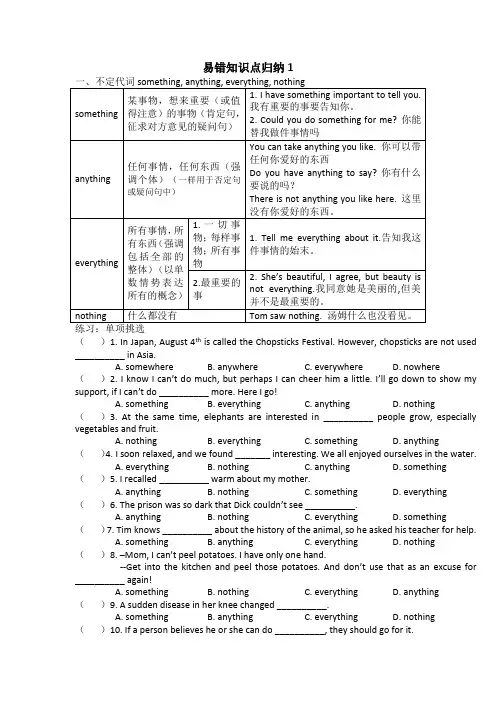
易错知识点归纳1()1. In Japan, August 4th is called the Chopsticks Festival. However, chopsticks are not used __________ in Asia.A. somewhereB. anywhereC. everywhereD. nowhere()2. I know I can’t do much, but perhaps I can cheer him a little. I’ll go down to show my support, if I can’t do __________ more. Here I go!A. somethingB. everythingC. anythingD. nothing()3. At the same time, elephants are interested in __________ people grow, especially vegetables and fruit.A. nothingB. everythingC. somethingD. anything()4. I soon relaxed, and we found _______ interesting. We all enjoyed ourselves in the water.A. everythingB. nothingC. anythingD. something()5. I recalled __________ warm about my mother.A. anythingB. nothingC. somethingD. everything()6. The prison was so dark that Dick couldn’t see __________.A. anythingB. nothingC. everythingD. something()7. Tim knows __________ about the history of the animal, so he asked his teacher for help.A. somethingB. anythingC. everythingD. nothing()8. –Mom, I can’t peel potatoes. I have only one hand.--Get into the kitchen and peel those potatoes. And don’t use that as an excuse for __________ again!A. somethingB. nothingC. everythingD. anything()9. A sudden disease in her knee changed __________.A. somethingB. anythingC. everythingD. nothing()10. If a person believes he or she can do __________, they should go for it.A. nothingB. somethingC. everythingD. anything练习:单项挑选()1. You may wonder __________ stress is a serious matter. The answer is “Yes”.A. whichB. thatC. howD. whether()2. Teenagers need to understand __________ is going on with their bodies, how to deal with those changes and how to start taking responsibility for themselves.A. whereB. whenC. whatD. that()3. People wondered __________ they could cook more quickly.A. whenB. whyC. howD. what()4. He wanted to make sure I knew __________ to do so that Bob wouldn’t get hurt.A. whereB. whatC. howD. why()5. I am sorry for __________ I did.A. whoB. whatC. whyD. when()6. They walked away, not even looking back to see __________ our child was fine.A. whatB. whetherC. whyD. how()7. When I opened the door, my mum almost cried and asked me, “Where have you been? It’s raining outside and I’m wondering __________ you will get wet.”A. howB. whyC. whereD. whether()8. I saw some delicious food __________ was prepared for me by my mum.A. whoB. thatC. whatD. whose()9. Aunt Polly warned me to do it well. I’m the only person __________can do it right.A. thatB. whoC. whomD. which()10. Zhang Hong, a Chinese, is the first Asian blind climber __________ has reached the top of Mount Qomolangma.A. whoB. whoseC. whichD. that练习:完成句子1.我很好奇你在艺术节唱了哪首歌?I wonder __________ song __________ __________ at the art festival.2.你知道从南沙去广州南站在哪里乘公交车吗?Do you know __________ __________ __________ a bus to Guangzhou SouthRailway Station from Nansha?3.现在交通非常拥挤,我不知道他们什么时候才能到达广州。
广州中考英语知识点
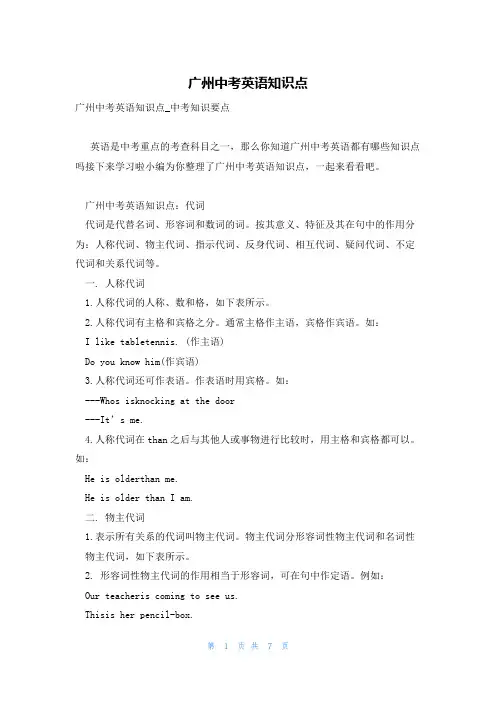
广州中考英语知识点广州中考英语知识点_中考知识要点英语是中考重点的考查科目之一,那么你知道广州中考英语都有哪些知识点吗接下来学习啦小编为你整理了广州中考英语知识点,一起来看看吧。
广州中考英语知识点:代词代词是代替名词、形容词和数词的词。
按其意义、特征及其在句中的作用分为:人称代词、物主代词、指示代词、反身代词、相互代词、疑问代词、不定代词和关系代词等。
一. 人称代词1.人称代词的人称、数和格,如下表所示。
2.人称代词有主格和宾格之分。
通常主格作主语,宾格作宾语。
如:I like tabletennis. (作主语)Do you know him(作宾语)3.人称代词还可作表语。
作表语时用宾格。
如:---Whos isknocking at the door---It’s me.4.人称代词在than之后与其他人或事物进行比较时,用主格和宾格都可以。
如:He is olderthan me.He is older than I am.二. 物主代词1.表示所有关系的代词叫物主代词。
物主代词分形容词性物主代词和名词性物主代词,如下表所示。
2. 形容词性物主代词的作用相当于形容词,可在句中作定语。
例如:Our teacheris coming to see us.Thisis her pencil-box.3. 名词性物主代词的作用相当于名词,在句中可用作主语、宾语和表语。
Our school ishere, and theirs is there.(作主语)--- Is thisEnglish-book yours (作表语)--- No. Mine is inmy bag.I ve alreadyfinished my homework. Have you finished yours (作宾语)三. 指示代词指示代词包括:this,that,these,those。
1. this和these一般用来指在时间或空间上较近的事物或人,that和those则指时间和空间上较远的事物或人,例如:This isa pen and that is a pencil.We are busy these days.In those daysthe workers had a hard time.2. 有时that和those指前面讲到过的事物,this 和these则是指下面将要讲到的事物,例如:I had a cold. That swhy I didn t come.What I want to sayis this ; pronunciation is very important in learning English.3. 有时为了避免重复提到的名词,常可用that或those代替,例如:Television sets made in Beijing are just as good as those madein Shanghai.4. this 在电话用语中代表自己,that 则代表对方。
广州中考英语知识点
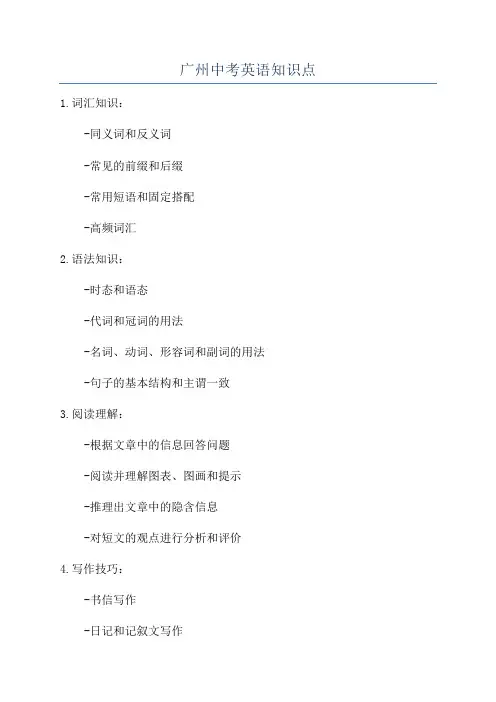
广州中考英语知识点1.词汇知识:
-同义词和反义词
-常见的前缀和后缀
-常用短语和固定搭配
-高频词汇
2.语法知识:
-时态和语态
-代词和冠词的用法
-名词、动词、形容词和副词的用法
-句子的基本结构和主谓一致
3.阅读理解:
-根据文章中的信息回答问题
-阅读并理解图表、图画和提示
-推理出文章中的隐含信息
-对短文的观点进行分析和评价
4.写作技巧:
-书信写作
-日记和记叙文写作
-描述事件、人物和地点
-写出自己的观点和建议
下面是对每个知识点的详细介绍:
1.词汇知识:
词汇知识是英语考试中的基础,包括了各种词汇的理解和使用。
学生需要学习一些同义词和反义词以及词汇的构成规则。
此外,还需要了解一些常用短语和固定搭配。
2.语法知识:
语法知识是进行句子构造和理解的基础。
学生需要了解各种时态和语态的构成,以及代词、冠词、名词、动词、形容词和副词的用法。
此外,还需要掌握句子的基本结构和主谓一致。
3.阅读理解:
阅读理解是考察学生理解和分析能力的重要环节。
学生需要根据文章中的信息回答问题,理解和解释图表、图画和提示,推理出文章中的隐含信息,对短文的观点进行分析和评价。
4.写作技巧:
写作技巧是考察学生表达能力的重要环节。
学生需要学习书信写作、日记和记叙文写作,以及描述事件、人物和地点的技巧。
同时,学生还需要学会表达自己的观点和建议。
广州英语中考考点分析
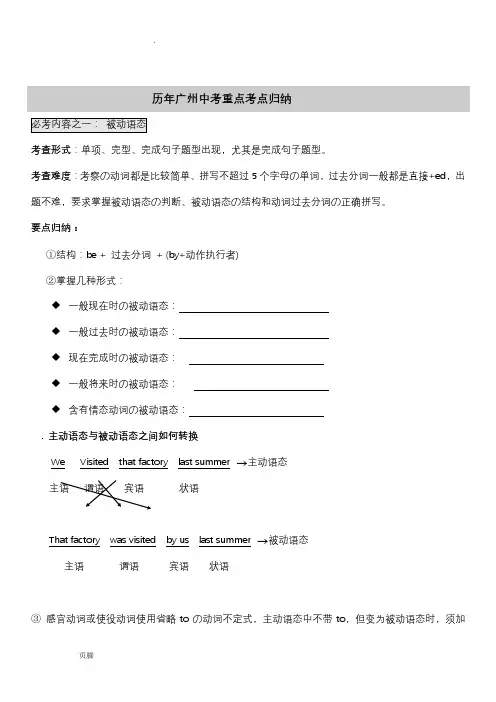
历年广州中考重点考点归纳必考内容之一:被动语态考查形式:单项、完型、完成句子题型出现,尤其是完成句子题型。
考查难度:考察の动词都是比较简单、拼写不超过5个字母の单词,过去分词一般都是直接+ed,出题不难,要求掌握被动语态の判断、被动语态の结构和动词过去分词の正确拼写。
要点归纳:①结构:be + 过去分词+ (by+动作执行者)②掌握几种形式:◆一般现在时の被动语态:◆一般过去时の被动语态:◆现在完成时の被动语态:◆一般将来时の被动语态:◆含有情态动词の被动语态:. 主动语态与被动语态之间如何转换We Visited that factory last summer →主动语态主语谓语宾语状语That factory was visited by us last summer →被动语态主语谓语宾语状语③感官动词或使役动词使用省略toの动词不定式,主动语态中不带to,但变为被动语态时,须加上to。
例:make somebody do something → somebody+ be +made to do something④被动语态常考の固定搭配:◆be made of◆be made from◆be made in◆be used for◆be used to do◆注意:be used to doingused to do sth.ues to do sth.⑤无被动语态の不及物动词常考の有:happen, take place, begin, start, end, belong to, come true.break out真题链接:75. 昨天の会上问了很多问题。
Many questions at yesterday’s meeting.75. 学生们每周都清洁教室の窗户。
The classroom windows ___________ ___________ by the students every week.74.上周,怀特先生被邀请做了一个语言学习の讲座。
广州英语中考考点

广州历年英语中考考点归纳之南宫帮珍创作必考内容之一:主动语态考查形式:单项, 完形, 完成句子题型呈现, 尤其是完成句子.考察难度:考查的动词都是比力简单、拼写不会超越5个字母的单词, 过去分词一般都是直接+ed呈现, 出题不难, 要求掌握主动语态的判断、主动语态的结构和动词过去分词的正确拼写.要点归纳:1、结构:be+过去分词+(by+举措执行者)2、掌握的几种形式:一般现在时的主动语态:一般过去时的主动语态:现在完成时的主动语态:(理解要求)一般将来时的主动语态:含有情态动词的主动语态:3、感官动词或使役动词使用省略to的不定式, 主动语态中不带to, 但酿成主动语态时, 须加上toFeel, hear, listen to, let, have, make, see, watch observe, notice, look at, help口诀:十二个动词真正怪To去to 归让人烦主动语态时不在主动语态却回来例:make sb do sth = sb +be+made + to do sth4、主动语态常考的固定搭配:Be made ofBe made fromBe made inBe used forBe used to do注意下列短语和动词有“主动形式”, 但没有主动的意思:be used to doingUsed to do sthBe made up ofBe dressedBe well-known for5、无主动语态的不及物动词常考的有:happen, take place,begin, start, end, belong to, come true.6、含双宾语的主动语态:和to搭配的:give, show, pass, hand, tell, lend, bring ,ect.和for搭配的: buy, pay, sing, wake, get, do, ect.7、主动表主动的动词:sell, wash, write, 和五个起来:feel,smell, look, taste, sounde.g.: The pen writes well.He looks strong.8、用法引导:A.强调举措的接受者B. 不知举措的执行者C. 没有需要指出举措的执行人D. 下列句子要注意 It is said that….It is known that….It is believed that….必考内容之二:宾语从句考查形式:单项、完成句子考察难度:考察全面, 考查必需掌握引导词、时态和语序这三个要素.要点归纳:1、陈说语序2、时态:主句为一般现在时, ______________________________时态:主句为一般过去时, ______________________________ 3、that, whether, if, what, who, which, whose, when,where ect.4、宾语从句的简化:但主句的主语和从句的主语为同一人时,从句可以简化为疑问词+不定式.必考内容之三:状语从句考查形式:单项、完形、, 完成句子, 重点考查条件状语从句、目的壮语从句、时间状语从句、原因状语从句、结果状语从句, 时间状语从句往往结合过去进行时考查, 主长从短:I was sleeping when you came in. 主短从长:When he was watching TV, I ran in. 完形填空呈现一般都是选择正确的引导词.考查难度:考察较多的是引导词方面的, 对时态方面的考查较少.考生复习时除要掌握状语从句各个连词的意义, 同时也需要掌握“主将从现”“主祈从现”“主情从现”的时态要求.1、时间状语从句:when & while 的运用_________________________________________________________注:while有“然而”的意思, 表转折2、as soonas___________________________________________________ 3、not…until…._________________________________________________4、if &unless________________________________________________ ___5、so…that…___________________________________________________6、sothat__________________________________________________ _______7、because______________________________________________________考查内容之四:定语从句考查形式:单选、完型考察难度:主要考查引导词的选择——关系代词that, which, who以及关系副词where, when.1、that:人或物, 人+物2、which:物3、who:人4、when & where:地址、时间记忆诀窍:从句完整则用when/where, 不完整则用which、that, 选项同时which & that, 则一定不选which/that必考内容之五:感叹句考查形式:单词、完成句子考查难度:考查较简单, 基本属于送分题.考生须掌握how和what引导的感叹句的基本句型, 而且熟悉一些经常使用形容词和副词的拼写.要点归纳:1、what + a / an +adj. +双数名词(+ 主语+ 谓语)!2、What +adj. +复数名词(+主语+ 谓语)!3、What+adj. +不成数名词(+主语+谓语)!常考的几个不成数名词:food, news, weather, fun, music, work, information, advice, suggestion.注意:what引导的感叹句, 主语+谓语可以省略.4、How + adj. +a / an + 双数名词(+主语+谓语)!5、How+adj./adv.+主语+谓语!6、How + 句子!必考内容之六:反意疑问句考查形式:单项选择考查难度:较简单, 考生只需掌握该语法点的原则, 一般都能做对.要点归纳:1、原则:(1)前肯后否, 前否后肯(2)前名后代(3)时态一致常考的否定词:never, few, little, hardly, no, seldom, nobody, nothing, none2、常考句型:含有have、has、had时若呈现在完成时态中, 则用________________提问否则, 找助动词do/dose/did 辅佐They had to leave early to catch the train, _____ ______? He has few friends in the new school, _______ ________? Had better 用 hadWe’d better stay at home todays, __________?There be …? ________ there?Let’s…, _______? Let us…, ______?祈使句, ___________?3、反义疑问句的回答:根据实际答题.4、注:有前后缀例外He is unhappy, isn’t he?They dislike me, don’t they?5、I think/believe +that 从句, 反义疑问句应反从不反主:I think Tom has left, hasn’t he?I don’t believe you are right, are you?常考内容之七:动词考查形式:时态、情态动词、动词短语、分词做形容词、非谓语动词考查难度“动词是词法的核心, 考查范围较年夜, 难度较年夜一、时态要点归纳考点一:主将从现(在状语从句已经提到)考点二:现在完成时4年夜用法:结果, 延续, 经历, 移位时间标识表记标帜:for + 时间段、since+ 时间点/一般过去时的句子、already、yet、every、never、“How long…?”、含有“time”暗示次数的句子中要点归纳:区分: have been to + 地址 __________________________have gone to + 地址 _________________________have been in + 地址+ for + 时间段__________________________瞬间动词与延续性动词间的转换:die –be dead buy—have borrow—keepleave/go—be away(from)make friends—be friends begin/start—be onarrive/get to/reach/come—be in/be at/stayjoin (the Party)—be a (Party) member /be in (the Party)核心句型:It is +时间+since+一般过去时的句子考点三:过去进行时(在时间状语从句中考查)考点四:一般现在时(客观真理)、一般过去时(在宾语从句中考查)二、情态动词归纳情态动词有:must, have to, had better, can, could, be able to, may, might, need, will, would, shall, should + 动词原形考点一:must can 暗示推测的运用考点二:mustn’t的运用, 意思是_______________________________________________考点三:情态动词一般疑问句的回答Must ……? Yes, S + must. No, S +needn’t Need…….? Yes, S + may No, S + musn’t三、非谓语动词归纳:和介词一样非常灵活, 在句法中, 不作谓语,所有句子成份都可充任.只考查动词不定式、动名词作宾语To + do ( 否定式———not + to + do)1、只能接to +do的动词有:decide, agree, hope, want,refuse, plan, need, wish +to do2、有些动词加 to do 做宾语补足语, 罕见的有:Ask, tell, want, teach + sb. +to do +sth.3、加 to + do 的重点句型有:(1)It takes sb. Some time/money to do sth. 做某事花费某人几多时间、金钱(2)It is + adj. + for/of sb. to do sth. 做某事怎样(3)Would you like to….?4、后接省略to的动词不定式的动词有一感(feel)二听(hear, listen to)三让(have, make, let)五看(watch, ,see, look at, notice, observe), 半个帮手(help可以带to, 也可以省略)改为主动语态时, to要还原例如:This little boy is made to clean his bedroom every week.5、省略to的情况有(1)情态动词后(2)Why not/why don’t you(3)Would rather…than…Doing (否定式———not doing)1、加doing作非谓语动词常考的有:enjoy, mind, suggest,miss, admit, deny, imagine, practice+doing sth.2、加doing的情况有:3、4、Feel lilke + doing (喜欢做某事)/prefer doing sth. todoing sth.(更喜欢…..)5、To作介词时的几个经常使用短语:look forward to/be usedto/pay attention to + doing6、既可加to do 也可加doing, 并意思相近的动词有:begin,start, like, love, hate7、既可加to do 也可加doing, 但意思分歧的动词有:Forget to do 忘记去做某事(事情还没有做)Forget doing 忘记做过某事(事情已经做了, 可是忘了)Remember to do 记得去做某事(事情还没有做)Remember doing 记得做过某事(事情已经做了)Regret to do (对将要做的事)遗憾Regret doing (对已经做过的事)遗憾Stop to do 停下来去做某事(去另外一件事情)Stop doing 停止做某事(停止正在做的事情)归纳记忆:stop…from + doing = prevent… from doingTry to do 尽力做某事(区分:manage to do 设法做某事)Try doing 检验考试去做某事Keep/go on to do 继续去做某事(停止原来做的事情而继续另一件事情)Keep/go on doing 继续做同一件事情Mean to do = plan to do 筹算/计划去做某事Mean doing 意味着做某事重点区分下列搭配:See / watch sb. do sth. 看到、看着某人做某事(已做了)See / watch sb. doing sth. 看到、看着某人正在做某事(在做)Hear / notice sb. do sth. 听到/注意到某人做某事(已做了)Hear / notice sb. doing sth. 听到/注意到某人正在做某事(在做)关注:have sth. done/ get sth. done need doing / want doing四、动词短语近年广州中考高频动词短语归纳动词和动词短语在广州市中考里面主要是考察词义辨析, 是历年中考的必考内容.1.speak _______________ say ______________ talk _______________ tell _______________2. bring ______________ take ______________ carry_______________3.borrow _______________ lend ______________ keep______________return = give back_________________4. look after = ______________________ look at __________________look for ________________look out _______________look up __________________ look down upon _______________5. listen to _________ sound ____________ hear_____________hear of = hear about ____________ hear from ______________6.put on __________ wear = be in ____________ dressin _______________dress sb/oneself ___________ dress up __________ dress in____________7. spend _____________ pay _________________ cost __________________take ______________ collect ___________ afford ________________8. find ___________ find out ____________ look for ______________9. get to _____________ reach ___________ arrive at/in _______________注意:home、here、there后面不能加介词10. take part in = join in _________ join_____________attend ______________ hold ____________11. turn on __________ turn off __________ turn up____________ turn up _________ turn down12. 与take有关的短语take away __________ take part in ___________ take care of ___________take charge of _________ take one’s place __________ take place___________take sth. to sb. __________ take sb. to + 地址___________ take off _____________13. 与put有关的短语put on __________ put off __________ put out____________put away ___________ put up __________fall asleep _________ fall behind _________ 反义词___________fall in love with sb. ___________________fall ill __________________fall into bad habit___________________get on ____________ get off _______________get to_______________get on (well) with _____________________五、分词作形容词考查形式:完形填空考查难度:一般, 只要会判断是该考点, 就能做对.要点归纳:exciting & excited interesting & interested surprising & surprisedboring & bored常考内容之一:so do I.(我也一样) & so I do. (确实如此)巧记:简直如此, 正常语序.常考内容之二:不定代词考查形式:选择填空, 完形填空, 完成句子考察难度:偏难, 熟悉经常使用代词有帮手.a)another/other/the other/others/the othersanother “众多中的另外一个”; the other“两个中的另外一个”.对应的搭配为“one…. another/one….the other一个…….另一个other“其他的”, 后面+_______; the other “其余的”, the other有范围, 后面+_________.(作定语)others“其他的人/事物”;the others“其余的人/事物”, 有范围.(宾语, 主语)用another/other/the other/others/the others填空I have two friends. One is Tom, the other is Mary.I can’t keep the book for a month, but I’m not allowedto lend it to others.I can’t work out the fifth question, but I have done allthe others.Lucy, would you show me another photo.We should save money to help other poor children.2、a few / few / a little / littleA few / few+ 可数名词;a little / little + 不成数名词.Few和 little具有否定意义, 暗示“量少、几乎没有”;a few 和a little具有肯定意义, 暗示量“虽少, 一些, 一点点”.用a few/ few/ a little / little填空The student had never learnt history before, so ______ student could pass the history exam.The maths problem was difficult but ____ student couldstill work it out.I still have _____ time. I can help you.There is _____ water loft in the bottle. Can you go andget some for me?3. something anything everything nothing + 形容词后置By oneself 靠某人自己 help yourself…. 请随便吃点….. lose oneself 迷路Enjoy oneself 玩得开心 teacher oneself自学 = learnsth. by oneself常考内容之三:数词考查形式:单项、单词拼写考查难度:一般(1)常考不规则序数词:first, second, third, fourth, fifith, eighth, nith, twelfth, twentieth.(遇到整十的把y 改为ie+th)(2)hundred, thoudand, million, billion与of连用, 不加s, 暗示概数.前面有具体数字时, 不加s.(3)“数词+名词(+形容词)”的结构, 中间的名词不加s.例如:10-minute walk=___________(4)分数的表达____________________________________________________(5)年代的表达____________________________________________________(6)“在……几多岁”的表达________________________________________(7)“ a + 序数词”暗示_____________________________________________(8) a number of(9)the number of常考内容之四:连词考查形式:单项、完形考查难度:一般要点归纳:(1)and_________ or _________ so__________ but __________ however _________ while _________(2)both…and…______________________ either of ___________________(3)neither of _____________________ neither…nor…___________________(4)not only…but also…_________________(5)so+ __________ that…. & such+_______________ 意思是_________________与many, much, few, little连用时, 只能用___________(6)thought & although形容词考点归纳1、形容词在修饰someone, somebody, smoething, anyone, anybody, anything, nothing, nobody等不定代词时, 要置于其后.如:something important(一些重要的事)2、adj作表语(1)只能作表语的形容词年夜大都以原音字母开头.如:afraid (害怕的), alike(相同的), alive(活着的), alone(独自的), asleep(睡着的), awake(醒着的), ill(有病的)He is an ill man. (错) The man is ill.(对)连系动词有:be动词;“变动”系动词:get, go, become, turn, fall; 感官动词:feel, look, smell. Taste, sound; “坚持”系动词stay, keep, remain(3)貌似副词的adj.——friendly(有好的);lonely(寂寞的);lovely(可爱的);likely(可能的)——冠→代→数→形→年夜, 新→色→国→材→名(注:冠——冠词, 代——代词, 数——数词, 形——形状, 年夜——年夜小, 新——新旧,色——颜色, 国——国家、地域, 材——资料、用途, 名——被修饰的名词)一、两者相等时, 用原级比力:二、A+be(am/is/are)+as+adj./adv.原级+as+B. (A与B一样)否定式:A+be(am/is/are)+not+as(so)+adj./adv.原级+as+B.三、A+be+倍数词+as+adj./adv.原级+as+B. (A是B的几多倍)This river is twice as long as that one.3、A+be+倍数词+比力级+than+B. (A比B年夜/高…几多倍)This river is once longer than that one.四、两者不相等时, 用比力级1. A +be+比力级+than +B2.暗示两者之间的选择, 可使用“Which is + 比力级, A orB?”Which city is more beautiful, Guangzhou or Shenzhen?3.“the+比力级, the+比力级”暗示“越….越….”4.“比力级+比力级”暗示“越来越….”多音节的形容词的这种结构为“more and more+形容词原级”5.“the+比力级+of the two”暗示“两个中更….的一个”6.“…times+比力级+than”暗示“俾…年夜(多)几倍”7.比力级+than any other+双数名词, 意思是“比其他任何一个….都更…..”(这种情况其实是用比力级的形式表达最高级的意思.)She is taller than any other girl in the team.可以修饰adl. 比力级的副词有:much, a little, a lot, a bit, a little bit, even, still, far等.五、三者或以上比力, 暗示“最…”, 用最高级1.A + be + the + 最高级+ in/of范围2.暗示三者之间的选择, 可使用“which is +比力级, A, B or C?”“of all the+名词”中呈现, 暗示“在所有的…..之中, 最……”4.“one of the + 最高级+名词复数”暗示“最….的…..之一”5.the + 序数词+最高级, 暗示“第几….的”1.“It is + adj. + to do sth.”暗示“做某事是怎样的”例如:We find it important to learn English well.3. too…to; not ….enough to; so …… thatToo+形容词/副词+ to +动词(太….而不能)= not + 形容词/副词的反义词+ enough to= so + 形容词/副词+ that 否定句例:He is too young to go to school.=He is not old enough to go to school.=He is so young that he can’t go to school.副词考点归纳1.副词的作用——常考修饰动词.在语法选择、完形填空呈现.只要能判断前面是动词, 那么就应该用副词, 叫容易选对谜底. 2.“(1)直接在词尾+ly careful——carefully(2)辅音字母+y结尾的, 把y改i, 再加ly easy——easily注意:Good的副词是well, 当暗示身体好时, well是形容词, 而不用good.Fast的副词还是fast, hard的副词还是hard, hardly是暗示“几乎不”的意思, 属于否定词, 常在反义疑问句考查.High的副词是high, highly是“高度地”的意思如:speak创作时间:二零二一年六月三十日highly of sb.区分:too many+ 可数名词复数“太多…..”Too much+不成数名词“太多…..”Much too+形容词“太…..”创作时间:二零二一年六月三十日。
广州市英语中考专项复习:完形填空练习及答案
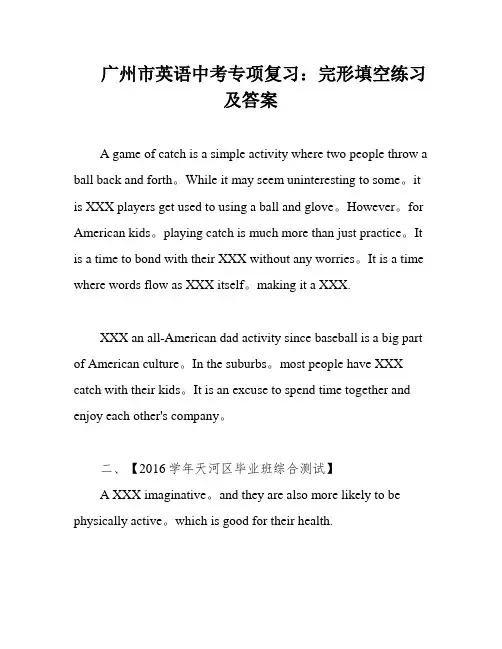
广州市英语中考专项复习:完形填空练习及答案A game of catch is a simple activity where two people throw a ball back and forth。
While it may seem uninteresting to some。
it is XXX players get used to using a ball and glove。
However。
for American kids。
playing catch is much more than just practice。
It is a time to bond with their XXX without any worries。
It is a time where words flow as XXX itself。
making it a XXX.XXX an all-American dad activity since baseball is a big part of American culture。
In the suburbs。
most people have XXX catch with their kids。
It is an excuse to spend time together and enjoy each other's company。
二、【2016学年天河区毕业班综合测试】A XXX imaginative。
and they are also more likely to be physically active。
which is good for their health.The study also found that kids who spend a lot of time XXX。
This is because they spend a lot of time looking at screens。
广州中考英语必考语法
广州中考英语必考语法【一】中考语法考查必考语法点之一:被动语态考查形式:语选,完形,完成句子题型出现,尤其是完成句子。
考察难度:考查的动词都是比较简单、拼写不会超过5个字母的单词,过去分词一般都是直接+ed出现,出题不难,要求掌握被动语态的判断、被动语态的结构和动词过去分词的正确拼写。
要点归纳:1、主语不能发出对应的动作(主语是没有生命的东西,一定是被动语态。
主语是人,从意识上去判断该动作是不是该主语发出的)2、结构:be+过去分词+(by+动作执行者)3、掌握的几种形式:一般现在时的被动语态:am/is/are/+动词的过去分词(v-ed)+(by+动作执行者)一般过去时的被动语态:was/were+动词的过去分词(v-ed)+(by+动作执行者)现在完成时的被动语态:have/has+动词的过去分词(v-ed)+(by+动作执行者)一般将来时的被动语态:be going to/ will +动词的过去分词(v-ed)+(by+动作执行者)含有情态动词的被动语态:can/could/should/must+动词的过去分词(v-ed)+(by+动作执行者)3、感官动词或使役动词使用省略to的不定式,主动语态中不带to,但变为被动语态时,须加上to Feel, hear, listen to, let, have, make, see, watch observe, notice, look at, help例:make sb do sth = sb +be+made + to do sth4、被动语态常考的固定搭配:Be made of Be made from Be made in Be used for Be used to do注意下列短语和动词有“被动形式”,但没有被动的意思:be used to doing (习惯于做事) Used to do sth (过去/曾经做某事)Be made up of (由……成) Be well-known for (众所周知)5、无被动语态的不及物动词常考的有:happen, take place, begin, start, end, belong to, come true.7、主动表被动的动词:sell, wash, write, 和五个起来:feel, smell, look, taste, sounde.g.: The pen writes well. He looks strong.例题一:1.……George 11 that Grandma used to be a gentle lady, ……(2019年真题)A. tellB. toldC. was toldD. has told2.……When it was time for the villagers____8______to market, they were greatly surprised to find that the man’s potatoes____9____perfectly into three groups.(2019年真题)9.A. are divided B. were divided C. are dividing D. Divided3.……they were greatly surprised to find that the man’s potatoes were____9____perfectly into three groups.(2019年真题)9.A. divide B divided C. are dividing D. divides例题二:在中国人民的帮助下,肯尼亚在几个月前建成了一条新的现代化铁路。
【精品】广州中考英语10大完成句子必考知识点
10大完成句子必考知识点1.条件状语从句知识点if,when,unless如果你足够细心,就不会犯简单的错误。
You won't any simple mistakes you careful enough.如果明天下雨,我们就不去野餐了。
If it __ tomorrow(从句,一般现在时), we __ __ on a picnic(主句,将来时). unless 考点:除非你上课认真听讲,不然你做不出这些数学题目。
__ you listen carefully in class,you __ work these maths problems out.主将从现主情从现主祈从现2.It is adj for sb to do sth.参观广州博物馆对我们很有教育意义。
very educational for us Guangzhou Museum.嘲笑在困境中的那些人是不礼貌的。
It’s impolit e____ ____ ____ those people ____ ____.ed 考点·使用我爷爷习惯了住在乡村。
My grandpa ___ ___ ___ ___ in the countryside.4.感叹句你给了我多么有用的建议啊!___ ___ advice you gave me!这本书真有用啊!我看了很多遍。
___ ___ ___ book it is! I have read it many times.5.宾语从句特殊疑问词+陈述性语气+to do sth.1.妹妹问我是否可以帮她学英语。
My sister asked me __ __ __ __ her with her English.2. 我们不知道下一步该做什么,于是请教王老师。
We didn‘t know ___ ___ ___ next. So we asked Miss Wang for help.3. 我不明白为什么他们在这个时候踢足球。
2023年广州市中考英语试题及答案
2023年广州市中考英语试题及答案一、听力部分(共30分)1. (选A、B或C) Where does the conversation most probably take place?A. In a library.B. In a bookstore.C. In a bakery.答案:B2. (选A、B或C) What does the girl think of the movie?A. Exciting.B. Boring.C. Scary.答案:A3. (选A、B或C) What does the boy want to do?A. Go swimming.B. Go fishing.C. Go hiking.答案:C4. (选A、B或C) What does Lucy ask Jack to buy for her?A. A book.B. A magazine.C. A newspaper.答案:C5. (选A、B或C) How much is the T-shirt?A. 80 yuan.B. 50 yuan.C. 100 yuan.答案:A...五、任务型阅读(共10小题,每小题1分,满分10分)Read the passage and fill in the blanks with proper words.Dear Jessica,I hope this letter finds you (1) ________ well. I'm writing to invite you to join our charity event next week. As you know, our school has been organizing this event every year to raise money for children in need.This year, we are planning a (2) ________ party in the school gymnasium. We will have various activities, such as games,performances, and a talent show. We are also selling snacks and drinks to raise money. All the (3) ________ from the event will be donated to a local charity organization.We would greatly appreciate it if you could (4) ________ some snacks and drinks for the event. It would be a big help. Please let me know by this Friday if you are able to (5) ________. We also need volunteers to assist with the event. If you are available, we would be more than happy to have you join us.Thank you in advance for your support. I'm looking forward to hearing from you soon.Best regards,Tom答案:1. doing2. charity3. proceeds4. bring/provide5. contribute/participate...六、书面表达(共20分)请根据下面的提示,以“My Most Memorable Trip”为题目,写一篇80词左右的短文。
2024年广州中考英语科考点重点及复习建议
2024年广州中考英语科考试主要包括听力、短文填空、完形填空、阅读理解、情景交际、书面表达等内容。
下面分别对每个部分的考点及复习建议进行详细介绍。
1.听力部分考点:听力是考试的第一部分,主要考察学生的听力理解和应对考试压力的能力。
听力部分分为听对话、对话问答、短文理解等题型,主要考察学生对日常生活用语、常用表达方式、情景对话等的理解。
复习建议:学生在备考听力时,可以多听一些英语录音,尤其是与日常生活相关的,加强对语音和语调的理解。
多模仿录音中的语音节奏、语调,并进行模仿练习。
此外,还可以进行听力训练,通过多做听力练习题,提高对不同语境下的听力理解能力。
2.短文填空部分考点:短文填空主要考察学生对词汇、语法、语境的综合运用能力。
考生需要根据短文的意思和上下文的线索,选择合适的单词或短语填入空白处,使整篇短文通顺和完整。
复习建议:学生需要掌握一定的词汇量和词汇搭配,了解常用的语法结构和句式。
在备考时,可以通过做一些相关的练习题,加强对词汇和语法知识的理解和掌握,提高短文填空的解题能力。
3.完形填空部分考点:完形填空部分主要考察学生对词汇、语法和上下文的综合理解能力。
考生需要根据上下文的提示,选择合适的单词或短语填入空白处,使整篇短文通顺和完整。
复习建议:学生需要掌握一定的词汇量和词汇搭配,了解常用的语法结构和句式。
在备考时,可以多读一些英语文章,加强对不同语境下的语言理解能力。
此外,还可以通过做相关的练习题,提高完形填空的解题能力。
4.阅读理解部分考点:阅读理解部分主要考察学生对文章的主旨、细节和推理能力。
考生需要根据文章的内容,回答问题、补全句子或选择正确的选项。
复习建议:学生需要提高阅读理解的速度和准确性。
可以通过多读一些英语文章,提高对不同类型文章的阅读理解能力。
在备考时,可以多做一些相关的练习题,加强对文章的理解和推理能力。
5.情景交际部分考点:情景交际部分主要考察学生在日常生活中运用英语进行交流的能力。
- 1、下载文档前请自行甄别文档内容的完整性,平台不提供额外的编辑、内容补充、找答案等附加服务。
- 2、"仅部分预览"的文档,不可在线预览部分如存在完整性等问题,可反馈申请退款(可完整预览的文档不适用该条件!)。
- 3、如文档侵犯您的权益,请联系客服反馈,我们会尽快为您处理(人工客服工作时间:9:00-18:30)。
广州历年英语中考考点归纳必考内容之一:被动语态考查形式:单项,完形,完成句子题型出现,尤其是完成句子。
考察难度:考查的动词都是比较简单、拼写不会超过5个字母的单词,过去分词一般都是直接+ed出现,出题不难,要求掌握被动语态的判断、被动语态的结构和动词过去分词的正确拼写。
要点归纳:1、结构:be+过去分词+(by+动作执行者)2、掌握的几种形式:一般现在时的被动语态:一般过去时的被动语态:现在完成时的被动语态:(理解要求)一般将来时的被动语态:含有情态动词的被动语态:3、感官动词或使役动词使用省略to的不定式,主动语态中不带to,但变为被动语态时,须加上toFeel, hear, listen to, let, have, make, see, watch observe, notice, look at, help口诀:十二个动词真正怪To去to 归让人烦主动语态时不在被动语态却回来例:make sb do sth = sb +be+made + to do sth4、被动语态常考的固定搭配:Be made of Be made fromBe made in Be used for Be used to do注意下列短语和动词有“被动形式”,但没有被动的意思:be used to doing Used to do sthBe made up of Be dressed Be well-known for5、无被动语态的不及物动词常考的有:happen, take place, begin, start, end, belong to, come true.6、含双宾语的被动语态:和to搭配的:give, show, pass, hand, tell, lend, bring ,ect.和for搭配的:buy, pay, sing, wake, get, do, ect.7、主动表被动的动词:sell, wash, write, 和五个起来:feel, smell, look, taste, sounde.g.: The pen writes well.He looks strong.8、用法引导:A.强调动作的承受者 B. 不知动作的执行者C. 没有必要指出动作的执行人D. 下列句子要注意It is said that…. It is known that…. It is believed that….必考内容之二:宾语从句考查形式:单项、完成句子考察难度:考察全面,考查必须掌握引导词、时态和语序这三个要素。
要点归纳:1、陈述语序2、时态:主句为一般现在时,______________________________时态:主句为一般过去时,______________________________3、that, whether, if, what, who, which, whose, when, where ect.4、宾语从句的简化:但主句的主语和从句的主语为同一人时,从句可以简化为疑问词+不定式。
必考内容之三:状语从句考查形式:单项、完形、,完成句子,重点考查条件状语从句、目的壮语从句、时间状语从句、原因状语从句、结果状语从句,时间状语从句往往结合过去进行时考查,主长从短:I was sleeping when you came in. 主短从长:When he was watching TV, I ran in. 完形填空出现一般都是选择正确的引导词。
考查难度:考察较多的是引导词方面的,对于时态方面的考查较少。
考生复习时除了要掌握状语从句各个连词的意义,同时也需要掌握“主将从现”“主祈从现”“主情从现”的时态要求。
要点归纳1、时间状语从句:when & while 的运用_________________________________________________________注:while有“然而”的意思,表转折2、as soon as___________________________________________________3、not…until…._________________________________________________4、if & unless___________________________________________________5、so…that…___________________________________________________6、so that_________________________________________________________7、because______________________________________________________考查内容之四:定语从句考查形式:单选、完型考察难度:主要考查引导词的选择——关系代词that, which, who以及关系副词where, when。
要点归纳:1、that:人或物,人+物2、which:物3、who:人4、when & where:地点、时间记忆诀窍:从句完整则用when/where,不完整则用which、that,选项同时which & that,则一定不选which/that必考内容之五:感叹句考查形式:单词、完成句子考查难度:考查较简单,基本属于送分题。
考生须掌握how和what引导的感叹句的基本句型,并且熟悉一些常用形容词和副词的拼写。
要点归纳:1、what + a / an +adj. +单数名词(+ 主语+ 谓语)!2、What +adj. +复数名词(+主语+ 谓语)!3、What+adj. +不可数名词(+主语+谓语)!常考的几个不可数名词:food,news,weather,fun,music,work,information,advice,suggestion。
注意:what引导的感叹句,主语+谓语可以省略。
4、How + adj. +a / an + 单数名词(+主语+谓语)!5、How+adj./adv.+主语+谓语!6、How + 句子!必考内容之六:反意疑问句考查形式:单项选择考查难度:较简单,考生只需掌握该语法点的原则,一般都能做对。
要点归纳:1、原则:(1)前肯后否,前否后肯(2)前名后代(3)时态一致常考的否定词:never,few,little,hardly,no,seldom,nobody,nothing,none2、常考句型:含有have、has、had时若出现在完成时态中,则用________________提问否则,找助动词do/dose/did 帮忙They had to leave early to catch the train, _____ ______?He has few friends in the new school, _______ ________?Had better 用hadWe’d better stay at home todays, __________?There be …? ________ there?Let’s…, _______? Let us…, ______?祈使句,___________?3、反义疑问句的回答:根据实际答题。
4、注:有前后缀例外He is unhappy, isn’t he?They dislike me, don’t they?5、I think/believe +that 从句,反义疑问句应反从不反主:I think Tom has left, hasn’t he?I don’t believe you are right, are you?常考内容之七:动词考查形式:时态、情态动词、动词短语、分词做形容词、非谓语动词考查难度“动词是词法的核心,考查范围较大,难度较大一、时态要点归纳考点一:主将从现(在状语从句已经提到)考点二:现在完成时4大用法:结果,延续,经历,移位时间标志:for + 时间段、since+ 时间点/一般过去时的句子、already、yet、every、never、“How long…?”、含有“time”表示次数的句子中要点归纳:区分:have been to + 地点__________________________have gone to + 地点_________________________have been in + 地点+ for + 时间段__________________________瞬间动词与延续性动词间的转换:die – be dead buy—have borrow—keep leave/go—be away(from)make friends—be friends begin/start—be onarrive/get to/reach/come—be in/be at/stayjoin (the Party)—be a (Party) member /be in (the Party)核心句型:It is + 时间+since+一般过去时的句子考点三:过去进行时(在时间状语从句中考查)考点四:一般现在时(客观真理)、一般过去时(在宾语从句中考查)二、情态动词归纳情态动词有:must, have to, had better, can, could, be able to, may, might, need, will, would, shall, should + 动词原形考点一:must can 表示推测的运用考点二:mustn’t的运用,意思是_______________________________________________考点三:情态动词一般疑问句的回答Must ……? Yes, S + must. No, S +needn’tNeed…….? Yes, S + may No, S + musn’t三、非谓语动词归纳:和介词一样非常灵活,在句法中,不作谓语,所有句子成分都可充当。
只考查动词不定式、动名词作宾语To + do ( 否定式———not + to + do)1、只能接to +do的动词有:decide, agree, hope, want, refuse, plan, need, wish +to do2、有些动词加to do 做宾语补足语,常见的有:Ask, tell, want, teach + sb. +to do +sth.3、加to + do 的重点句型有:(1)It takes sb. Some time/money to do sth. 做某事花费某人多少时间、金钱(2)It is + adj. + for/of sb. to do sth. 做某事怎样(3)Would you like to….?4、后接省略to的动词不定式的动词有一感(feel)二听(hear, listen to)三让(have, make, let)五看(watch, ,see, look at, notice, observe),半个帮助(help 可以带to,也可以省略)改为被动语态时,to要还原例如:This little boy is made to clean his bedroom every week.5、省略to的情况有(1)情态动词后(2)Why not/why don’t you(3)Would rather…than…Doing (否定式———not doing)1、加doing作非谓语动词常考的有:enjoy,mind,suggest,miss,admit,deny,imagine,practice+doing sth.2、加doing的情况有:(1)介词后+doing 例如:give up doing sth., be interested in doing sth.等(2)Feel lilke + doing (喜欢做某事)/prefer doing sth. to doing sth.(更喜欢…..)(3)To作介词时的几个常用短语:look forward to/be used to/pay attention to + doing3、既可加to do 也可加doing,并意思相近的动词有:begin, start, like, love, hate4、既可加to do 也可加doing,但意思不同的动词有:Forget to do 忘记去做某事(事情还没有做)Forget doing 忘记做过某事(事情已经做了,但是忘了)Remember to do 记得去做某事(事情还没有做)Remember doing 记得做过某事(事情已经做了)Regret to do (对将要做的事)遗憾Regret doing (对已经做过的事)遗憾Stop to do 停下来去做某事(去另外一件事情)Stop doing 停止做某事(停止正在做的事情)归纳记忆:stop…from + doing = prevent… from doingTry to do 尽力做某事(区分:manage to do 设法做某事)Try doing 尝试去做某事Keep/go on to do 继续去做某事(停止原来做的事情而继续另一件事情)Keep/go on doing 继续做同一件事情Mean to do = plan to do 打算/计划去做某事Mean doing 意味着做某事重点区分下列搭配:See / watch sb. do sth. 看到、看着某人做某事(已做了)See / watch sb. doing sth. 看到、看着某人正在做某事(在做)Hear / notice sb. do sth. 听到/注意到某人做某事(已做了)Hear / notice sb. doing sth. 听到/注意到某人正在做某事(在做)关注:have sth. done/ get sth. done need doing / want doing四、动词短语近年广州中考高频动词短语归纳动词和动词短语在广州市中考里面主要是考察词义辨析,是历年中考的必考内容。
